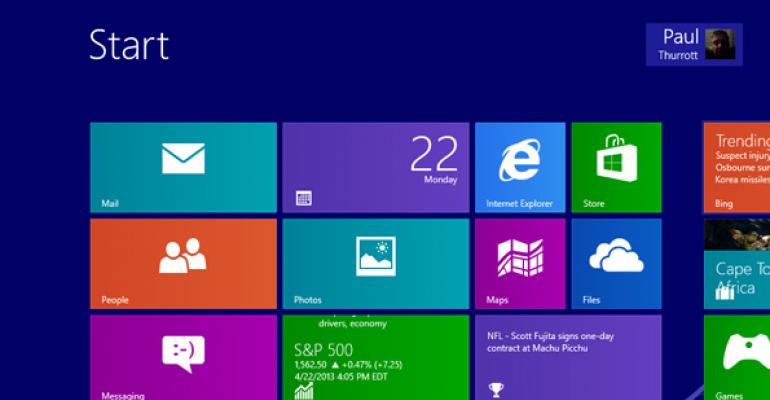News emerged this past week that Microsoft will make changes to Windows 8 in the “Blue” update that will ship later this year and accommodate users who are disgruntled by the removal of key legacy interfaces. If true—and my own sources say it’s happening—then this shows a none-too-subtle change in the direction Windows takes going forward. And that’s good news.
The issue is obvious enough: For the first time perhaps ever, Microsoft really pushed the boundaries of what Windows is in Windows 8, tacking two OSs—the traditional Windows desktop, or Explorer, plus a new mobile OS I call Metro—into a single system. It did this because it sees the future of mainstream computing the way I do, as highly mobile and highly connected, and realized that shipping the mobile OS—the Metro bit—separately from Windows would have been disastrous, leading to an even faster retraction of the traditional PC market than we’re now seeing. Only by melding Metro with Windows could Microsoft generate enough usage to ensure it a place in the future market for mainstream mobile computing.
Of course, Microsoft’s strategy wasn’t completely successful: It needed to ship Windows 8 quickly too, to prevent further gains made by mobile competitors such as Apple iOS and Google Android. So the version of Windows 8 that shipped in October 2012 was woefully incomplete and immature, as I’ve written and discussed elsewhere. To be clear, the desktop part of Windows 8—what used to be all of Windows—is quite mature and usable, as you might expect. It’s Metro—and the pesky Metro/desktop interaction bits—the need work.
I wrote about the need to fix Windows 8 and Microsoft’s culture of rewarding product shipping above all else in the article "In Praise of Finishing a Job." With Windows 8 and related products like Office 2013, Microsoft has begun delivering and servicing traditional software applications like online services, and plans to update them on an ongoing basis. That’s obviously a positive sign, and while the Office team has what can only be described as a superior plan for doing that—quarterly updates that will include both functional changes as well as security fixes—Windows is at least silently coming along for the ride.
Publicly, we’ve seen some reasonably decent updates to most of the built-in Metro-style apps, but privately the company is also working that “Blue” update, which I think of as combination feature pack and service pack, or a “GA + 1” update, meaning something that will appear roughly one year after the general availability of the original release of Windows 8. According to the several leaked builds I’ve seen so far, it will be branded as Windows 8.1 for some reason.
The leaked “Blue” builds show that Microsoft is shoring up the Metro side of Windows 8, which makes plenty of sense given my earlier comments about the maturity of that platform. But what we don’t see in these builds is another related development, that Microsoft will be returning some legacy Windows user interfaces to Windows 8. More specifically, it will be adding back the Start button (but not the Start menu) and the ability to boot directly into the desktop.
Reaction to these changes has been decidedly mixed. On the one hand, we have a suddenly vocal group of Metro purists who believe that Microsoft did the right thing by abandoning the past and creating what it calls a “touch first” UI for Windows 8. But on the other hand, we have a very frustrated crowd of Windows users who are flummoxed by the changes in Windows 8 and are not even slightly interested in upgrading. This latter group notably includes many businesses which, let’s face, have absolutely no interest in re-training users at all.
As I noted last weekend in "Maybe They Should Just Call It Windows 7.8," Microsoft’s decision to finally start listening to customers is notable for a number of reasons, and shouldn’t be considered a back-tracking of any kind. Previous versions of Windows that foisted new UIs on users, like Windows 95 with its then-new Explorer UI, and XP, with its double-wide Start menu, offered confused users a way to go back to the previous UIs so they could more easily transition. Windows 8 offered no such concession, instead opting for an Apple-like decisiveness for a vision of the future that might also be accurately described as an Apple-like stubbornness.
As I’ve said so often, Microsoft is no Apple. And its ability, pre-Windows 8, to give a diverse user base choices was always a huge strength. Decisiveness is a great trait when you make good decisions. But for the billion-plus users on traditional PCs, Metro is not a good decision. And continually ignoring users’ needs is a strange form of corporate suicide.
I was told by sources at Microsoft that the decision to bring back the Start button was actually forced on the Windows team from above. This doesn’t surprise me: The Windows team didn’t just ignore users when it designed Windows 8—the six years that Steven Sinofsky ran this division are most succinctly remembered for a tired disinterest in customer feedback—they also managed to ignore the Windows Phone team, which learned the pitfalls of working with the Metro design first. So in Blue, we see some of the same UI backtracks that the Windows Phone team first applied back in 2011, including visible, context-sensitive search UIs, instead of relying on users to just know about the system-wide search (which, in Windows 8, is a semi-secret of sorts, since it’s hidden by default).
This kind of insular product design isn’t just shameful, it’s dangerous to Microsoft’s future and to Microsoft’s customer base. So while much of this year will be spent dissecting what’s changing in Blue, mark my words: The biggest change is that the Windows team is finally doing right by its customers again. This is a most welcome development.




